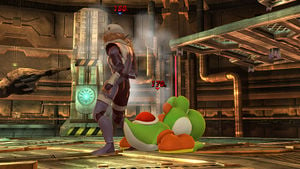Rage
Rage is a mechanic introduced in Super Smash Bros. 4. It was originally discovered by the Japanese community at the launch of Super Smash Bros. for Nintendo 3DS in September 14, 2014, and was first referred to as the "Hot Hot Effect". Ayuha and Chibo worked together to make a tutorial video on it and bring the information to the western scene, where Chibo then named it the "Rage Effect". Rage functions similarly to Aura: a character's attacks will deal increased knockback as they accumulate more damage, though it does not affect an attack's damage output. Rage is visually denoted by characters flashing red and emitting steam when they reach 100%,[1] which become more visually intense as the characters' damage increases until 150%; in Super Smash Bros. Ultimate, their portraits in the damage meter emit smoke as well. However, rage starts applying long before these visual indicators appear.
In Super Smash Bros. 4
Rage's multiplier is 1 + [(p - 35)/115 * 0.15], where p is the damage of the attacker, and only takes values between 35 and 150.[2]. Thus, rage begins to take effect past 35% and caps at 150%, with the minimum possible multiplier being 1× (no rage) and the maximum possible multiplier being 1.15× (all knockback is increased by 15%). This multiplier is applied to the end of the knockback formula (as the variable r), alongside other conditional ratios, such as crouch canceling (0.85×), smash attack charge interruption bonus (1.2×), and grounded meteor smash penalty (0.8×). This multiplier can also be directly applied to the base knockback and knockback scaling values of moves, resulting in the same effective knockback when calculated.
Like stale-move negation, rage is not present in single player modes, such as Training, though its visual effects are still present. As such, its effects can only be tested in Versus Mode.
The obvious application of rage is that it allows players at higher damages to score KOs earlier than they would be able to otherwise, which can help aid a losing player staging a comeback. However, rage is not necessarily a comeback-friendly mechanic. It can be used by players with leads to potentially survive for longer, as the player with a lower KO/stock count and damage cannot use their finishers as effectively. Furthermore, the increased knockback from rage can potentially prevent combos from working sooner than they normally would, especially in combos that involve set-ups from throws with high base knockback, thus preventing highly damaged players from increasing the damage on a less damaged player. Rage can potentially assist in combos that rely on stage-specific combos that rely on forcing opponents onto specific platforms, but these combos, even without rage, can be more difficult to perform than standard combos.
Generally, heavyweights benefit the most from rage, as their greater endurance allows them to both experience rage longer and to a greater degree. Furthermore, most heavyweights are less reliant on combos compared to other characters, allowing for the greater use of increased knockback with little concern of it preventing vital combos. Conversely, characters that can rack up damage quickly without rage can lose out on several combos they can potentially perform when they start building rage, especially those that rely on grab set-ups, such as R.O.B.. Lightweights also do not strongly benefit from rage, as their lower endurance can shrink the window for which they can take advantage of rage.
Rage applies even to portions of attacks that use set knockback. This causes abnormal behavior on attacks with linking hits that use high set knockback values in order for the target to keep up with the attacker, such as the initial hits of Mario's Super Jump Punch, Peach's Peach Parasol and Samus's grounded Screw Attack, instead causing them to knock targets much farther away from the attacker and potentially KO them at very low percentages. This is a commonly criticized aspect of rage, since characters with a high level of rage and such kinds of moves can pull off extremely rewarding comebacks with comparatively much lower risk, and their playstyle can degenerate to constantly putting opponents into positions where such early KOs are more likely to happen, such as on platforms or as a followup from vertical launching moves, as long as they have rage. Screw Attack is an infamous example of this, as with high rage, Samus can not only one-hit KO several floaty and/or light characters in midair with the grounded initial hits of the move, but can combo reliably into it from her dash attack, which is already one of her most useful moves.
In Super Smash Bros. Ultimate
Rage returns in Ultimate, though its effects have been nerfed. It has a slightly altered formula, which is 1 + [(p - 35)/115 * 0.1]. As a result, while it still takes effect past 35% and caps at 150%, it grows at a slower rate, and its maximum possible multiplier is now 1.1× (down from 1.15×). Additionally, it no longer applies to attacks that use set knockback, preventing moves with high set knockback values (such as the aforementioned) from KOing off the top blast line at disproportionately early percentages. These changes weaken rage as a comeback factor, while removing the early KO setups of characters such as Mario and Samus, but also allow for combos to work more consistently.
While not mentioned in-game, rage now takes effect in Training Mode alongside stale-move negation if the new Stale Moves option is turned on, allowing for its effects to be tested more conveniently. However, it remains absent from other single player modes.
